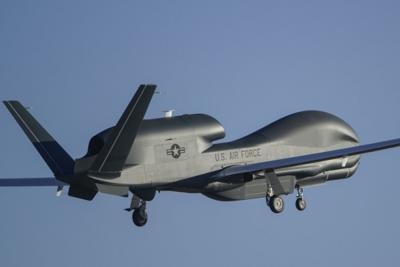Mon, Mar 24, 2014
Two Additional Aircraft To Be Delivered Later This Year
Northrop Grumman Corporation delivered a Global Hawk Block 40 Unmanned Aircraft System (UAS) to the U.S. Air Force at Grand Forks Air Force Base, N.D., ahead of schedule, Feb. 14. This is the second aircraft delivered as part of Global Hawk's Lot 10 contract, joining a Block 30 system delivered four months early in November of last year. Two additional aircraft, a final Block 30 and Block 40, will arrive later this year, completing Global Hawk's Lot 10 contract.

"Global Hawk program performance excellence is a core focus of our efforts. Delivering Global Hawk to our Air Force partners early is a good indicator of our solid performance," said Mick Jaggers, director, Global Hawk, Northrop Grumman Aerospace Systems. "We look forward to continuing the reduction of Global Hawk's total mission costs while providing unparalleled capabilities."
A total of 42 Global Hawk unmanned aircraft are currently in use around the world with 32 in the Air Force inventory. A contract for three more aircraft (Lot 11) is expected this summer. These additional aircraft will support increased operational flight hours without adding to the fixed support costs. As our fixed support costs remain constant and flying hours increase, Global Hawk's cost per flight hour will continue to decrease. The operationally proven Global Hawk program has exceeded 109,000 flight hours; and the cost per flight hour has declined significantly as the system has matured. The Air Force reports that the total cost per flight hour was $23,800 in fiscal year 2013, a decrease of almost 30 percent since 2012.
The Global Hawk performs vital intelligence, surveillance and reconnaissance. The Global Hawk Block 40 is equipped with a multiplatform radar technology insertion program (MP-RTIP) active electronically scanned array (AESA) radar with air-to-surface capability that provides wide-area surveillance of stationary and moving targets.
The Global Hawk's MP-RTIP sensor allows military commanders to gather near real-time imagery and detections of moving targets. The system completed an early operational capability demonstration in April 2013 for the Air Force to verify its ability to support antiterrorism operations, battlefield surveillance, and support of command and control operations.
(Global Hawk image from file)
More News
Terminal Radar Service Area Airspace surrounding designated airports wherein ATC provides radar vectoring, sequencing, and separation on a full-time basis for all IFR and participa>[...]
Aero Linx: Utah Back Country Pilots Association (UBCP) Through the sharing experiences, the UBCP has built upon a foundation of safe operating practices in some of the most challen>[...]
From 2010 (YouTube Edition): Imagine... Be The Change... Inspire FROM 2010: One of the more unusual phone calls I have ever received occurred a few years ago... from Anousheh Ansar>[...]
(Pilot) Felt A Shudder And Heard The Engine Sounding Differently, Followed By The Engine Chip Detector Light On April 14, 2025, about 1800 Pacific daylight time, a Bell 206B, N1667>[...]
Also: AMA Names Tyler Dobbs, More Falcon 9 Ops, Firefly Launch Unsuccessful, Autonomous F-16s The Air Force has begun ground testing a future uncrewed jet design in a milestone tow>[...]
 ANN's Daily Aero-Term (05.07.25): Terminal Radar Service Area
ANN's Daily Aero-Term (05.07.25): Terminal Radar Service Area ANN's Daily Aero-Linx (05.07.25)
ANN's Daily Aero-Linx (05.07.25) Classic Aero-TV: Anousheh Ansari -- The Woman Behind The Prize
Classic Aero-TV: Anousheh Ansari -- The Woman Behind The Prize NTSB Prelim: Bell 206B
NTSB Prelim: Bell 206B Airborne-NextGen 05.06.25: AF Uncrewed Fighters, Drones v Planes, Joby Crew Test
Airborne-NextGen 05.06.25: AF Uncrewed Fighters, Drones v Planes, Joby Crew Test



